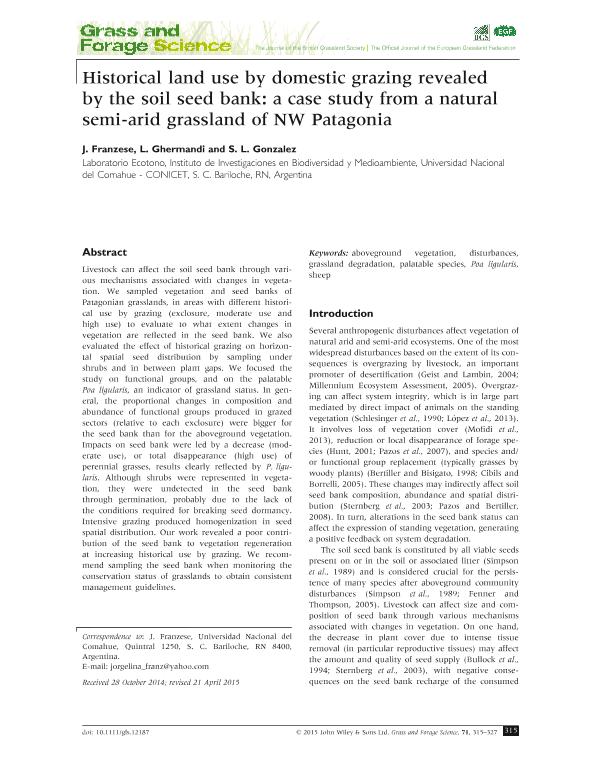Mostrar el registro sencillo del ítem
dc.contributor.author
Franzese, Jorgelina

dc.contributor.author
Ghermandi, Luciana

dc.contributor.author
Gonzalez, Sofia Laura

dc.date.available
2023-01-06T19:41:11Z
dc.date.issued
2015-07
dc.identifier.citation
Franzese, Jorgelina; Ghermandi, Luciana; Gonzalez, Sofia Laura; Historical land use by domestic grazing revealed by the soil seed bank: A case study from a natural semi-arid grassland of NW Patagonia; Wiley Blackwell Publishing, Inc; Grass and Forage Science; 71; 2; 7-2015; 315-327
dc.identifier.issn
0142-5242
dc.identifier.uri
http://hdl.handle.net/11336/183825
dc.description.abstract
Livestock can affect the soil seed bank through various mechanisms associated with changes in vegetation. We sampled vegetation and seed banks of Patagonian grasslands, in areas with different historical use by grazing (exclosure, moderate use and high use) to evaluate to what extent changes in vegetation are reflected in the seed bank. We also evaluated the effect of historical grazing on horizontal spatial seed distribution by sampling under shrubs and in between plant gaps. We focused the study on functional groups, and on the palatable Poa ligularis, an indicator of grassland status. In general, the proportional changes in composition and abundance of functional groups produced in grazed sectors (relative to each exclosure) were bigger for the seed bank than for the aboveground vegetation. Impacts on seed bank were led by a decrease (moderate use), or total disappearance (high use) of perennial grasses, results clearly reflected by P. ligularis. Although shrubs were represented in vegetation, they were undetected in the seed bank through germination, probably due to the lack of the conditions required for breaking seed dormancy. Intensive grazing produced homogenization in seed spatial distribution. Our work revealed a poor contribution of the seed bank to vegetation regeneration at increasing historical use by grazing. We recommend sampling the seed bank when monitoring the conservation status of grasslands to obtain consistent management guidelines.
dc.format
application/pdf
dc.language.iso
eng
dc.publisher
Wiley Blackwell Publishing, Inc

dc.rights
info:eu-repo/semantics/openAccess
dc.rights.uri
https://creativecommons.org/licenses/by-nc-sa/2.5/ar/
dc.subject
POA LIGULARIS
dc.subject
ABOVEGROUND VEGETATION
dc.subject
DISTURBANCES
dc.subject
GRASSLAND DEGRADATION
dc.subject
PALATABLE SPECIES
dc.subject
SHEEP
dc.subject.classification
Ecología

dc.subject.classification
Ciencias Biológicas

dc.subject.classification
CIENCIAS NATURALES Y EXACTAS

dc.title
Historical land use by domestic grazing revealed by the soil seed bank: A case study from a natural semi-arid grassland of NW Patagonia
dc.type
info:eu-repo/semantics/article
dc.type
info:ar-repo/semantics/artículo
dc.type
info:eu-repo/semantics/publishedVersion
dc.date.updated
2023-01-06T09:30:10Z
dc.journal.volume
71
dc.journal.number
2
dc.journal.pagination
315-327
dc.journal.pais
Reino Unido

dc.journal.ciudad
Londres
dc.description.fil
Fil: Franzese, Jorgelina. Consejo Nacional de Investigaciones Científicas y Técnicas. Centro Científico Tecnológico Conicet - Patagonia Norte. Instituto de Investigaciones en Biodiversidad y Medioambiente. Universidad Nacional del Comahue. Centro Regional Universidad Bariloche. Instituto de Investigaciones en Biodiversidad y Medioambiente; Argentina
dc.description.fil
Fil: Ghermandi, Luciana. Consejo Nacional de Investigaciones Científicas y Técnicas. Centro Científico Tecnológico Conicet - Patagonia Norte. Instituto de Investigaciones en Biodiversidad y Medioambiente. Universidad Nacional del Comahue. Centro Regional Universidad Bariloche. Instituto de Investigaciones en Biodiversidad y Medioambiente; Argentina
dc.description.fil
Fil: Gonzalez, Sofia Laura. Consejo Nacional de Investigaciones Científicas y Técnicas. Centro Científico Tecnológico Conicet - Patagonia Norte. Instituto de Investigaciones en Biodiversidad y Medioambiente. Universidad Nacional del Comahue. Centro Regional Universidad Bariloche. Instituto de Investigaciones en Biodiversidad y Medioambiente; Argentina
dc.journal.title
Grass and Forage Science

dc.relation.alternativeid
info:eu-repo/semantics/altIdentifier/doi/https://onlinelibrary.wiley.com/doi/10.1111/gfs.12187
dc.relation.alternativeid
info:eu-repo/semantics/altIdentifier/doi/http://dx.doi.org/10.1111/gfs.12187
Archivos asociados
